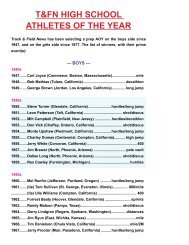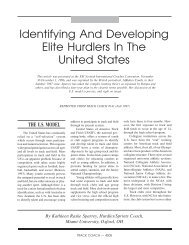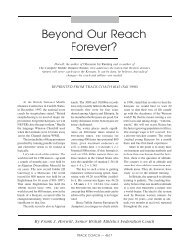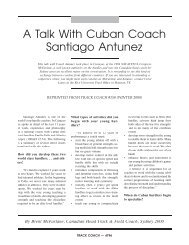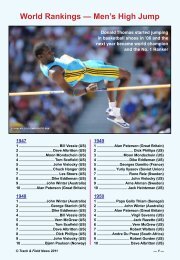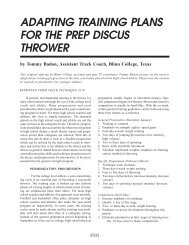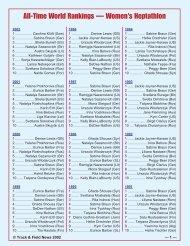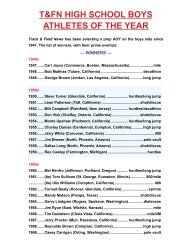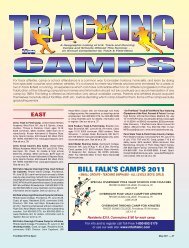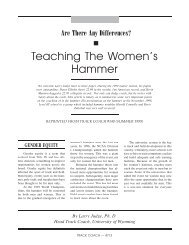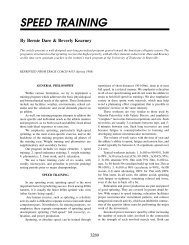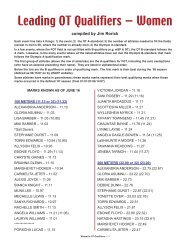Maximal Power Training (MPT) - Track & Field News
Maximal Power Training (MPT) - Track & Field News
Maximal Power Training (MPT) - Track & Field News
Create successful ePaper yourself
Turn your PDF publications into a flip-book with our unique Google optimized e-Paper software.
<strong>Maximal</strong> <strong>Power</strong> <strong>Training</strong><br />
(<strong>MPT</strong>)<br />
Vern Gambetta is well known to many readers as a coach, writer, founder of USATF’s<br />
Coaching Education, professional sports consultant, and even ex-editor of this esteemed<br />
periodical, among other things. When the call went out for articles, Vern responded<br />
immediately, and this piece is an excellent summary of the work of two Australian sports<br />
scientists, Greg Wilson and Robert Newton. In our opinion, Gambetta has always been on the<br />
cutting edge of training, and you will agree when you read this piece. For more information<br />
on what Gambetta is up to, his web site address is http://www.gambetta.com/main.html. This<br />
article has been reprinted with the kind permission of Eleanor Frankel, who edits <strong>Training</strong> and<br />
Conditioning. You may call 607/272-0265 to get further information on this journal. Currently,<br />
it comes out six times per year, but it will be bumped up to nine times in 1999.<br />
REPRINTED FROM TRACK COACH #145 (Fall 1998)<br />
The quest for the development of<br />
power as a means to improve sports<br />
performance is never ending. <strong>Training</strong><br />
methods to improve power have run the<br />
gamut from heavy weight training to<br />
light fast weight training to plyometrics<br />
where the acceleration and deceleration<br />
of the body is the overload.<br />
All these methods have produced<br />
results, although the results have not<br />
always been commensurate with the<br />
training time invested. As a coach I<br />
have tried many of the methods with<br />
varying degrees of success. I have<br />
always felt that there had to be a more<br />
systematic way to approach power<br />
development.<br />
In my continuing search to find<br />
a better way to train for power the<br />
research of Australian sport scientists<br />
Greg Wilson and Robert Newton appealed<br />
to me because of its practical<br />
application. I will attempt to summarize<br />
their research and give some<br />
practical ideas on the implementation<br />
of their concepts.<br />
<strong>Power</strong> is the application of<br />
strength with speed. Strength is only<br />
concerned with the application of force<br />
as expressed by the formula F x D. The<br />
time of the application of force is of<br />
no consideration; force production is<br />
the main goal.<br />
<strong>Power</strong> is expressed by the formula<br />
F x D/Time; here speed is of the essence.<br />
<strong>Power</strong> is the quality needed<br />
for performance in the athletic arena,<br />
where movements take place in less<br />
than .3 of a second.<br />
The training methods to achieve<br />
this kind of power are not new. They<br />
have been used for years by jumpers<br />
and throwers and more recently by<br />
sprinters and hurdlers in track & field.<br />
Explosive ballistic work was done out<br />
of necessity because their performance<br />
arena demands the highest expression<br />
of explosive power to propel their<br />
body or an implement with maximal<br />
velocity.<br />
To achieve maximal power the<br />
bar or the implement must accelerate<br />
throughout the movement. A major<br />
limitation of using weight training to<br />
achieve maximal power is that the bar<br />
must achieve zero velocity at the end<br />
of the concentric phase of the movement.<br />
This means that near the end<br />
of an exercise, whether it is a squat,<br />
clean or bench press, the bar must slow<br />
down in preparation for stopping.<br />
Research has shown that in a<br />
maximal lift 23% of the movement<br />
is accounted for by deceleration of<br />
the bar. In a lift at 81% of maximum<br />
the deceleration phase accounted for<br />
By Vern Gambetta, Gambetta Sports <strong>Training</strong> Systems<br />
TRACK COACH — 4630
52% of the concentric movement (Wilson<br />
1994). This is one of the major<br />
limitations of weight training for the<br />
development of maximal power.<br />
In addition, traditional weight<br />
training is unable to imitate specific<br />
sport movements. This is true of both<br />
machines or free weights.<br />
That is not to say that weight<br />
training is unimportant. Much to the<br />
contrary, it is very important to have a<br />
base of absolute strength, but as with<br />
any other method, it must be used at<br />
the proper place as part of an overall<br />
program. It can’t be the sole focus of<br />
the program. It is necessary to train<br />
across a broad continuum of speeds<br />
and external resistance to achieve<br />
optimum results. No one method will<br />
get the job done.<br />
In the search to utilize weights to<br />
raise explosive power one method that<br />
has been advocated is to lift lighter<br />
weights fast. Superficially it appears<br />
that the bar is moving fast but even this<br />
approach does not solve the problem<br />
as the bar is accelerated for only a<br />
short time at the first part of the movement.<br />
The rest of the lift involves the<br />
production of very little force since<br />
the work is directed at slowing down<br />
and stopping the bar at the end of the<br />
movement.<br />
High power production is best<br />
represented by sport activities like<br />
putting a shot put. throwing a baseball,<br />
swinging a golf club or a baseball bat.<br />
The common characteristic of all these<br />
activities is that the implement or ball<br />
is accelerated progressively throughout<br />
the movement until release or contact<br />
occurs. This results in high power production<br />
throughout the movement.<br />
According to Wilson (1994),<br />
“<strong>Maximal</strong> explosive power training<br />
involves performance of dynamic<br />
weight training at the load which maximizes<br />
mechanical power output.” This<br />
involves lifting loads in the range of<br />
30-45% of maximum at high speed.<br />
Based on the previous discussion<br />
it should be obvious that the exercises<br />
must not be the typical weight training<br />
exercises where the bar reaches zero<br />
velocity at the end of the movement.<br />
Therefore, to attempt <strong>Maximal</strong> <strong>Power</strong><br />
<strong>Training</strong> (<strong>MPT</strong>) with the traditional<br />
weight training exercises on machines<br />
or with free weights would be counterproductive<br />
to the stated goal of raising<br />
explosive power.<br />
<strong>MPT</strong> is a marriage between<br />
strength training and plyometrics.<br />
“<strong>Maximal</strong> power training could be<br />
considered a form of plyometrics<br />
training that is specifically performed<br />
at a load which maximizes the power<br />
output of the exercise” (Wilson 1994).<br />
The loading is greater than plyometrics<br />
because more resistance than body<br />
weight is used. But lighter than traditional<br />
weight training.<br />
The danger in this method is that<br />
due to external loading the exercises<br />
have greater impact forces as well as<br />
greater contact times at a slower velocity<br />
than using plyometric training<br />
where there is no external load. This<br />
makes it imperative that the athletes<br />
using this method have a very good<br />
training base or they will be at greater<br />
risk of injury.<br />
To effectively use <strong>MPT</strong>, exercises<br />
should be selected that allow for the<br />
production of the highest forces possible<br />
throughout the whole range of<br />
movement. One of the best examples of<br />
this type of movement is the weighted<br />
squat jump. The power potential for<br />
this exercise is very high. According<br />
to Baker, “The multiple repetition<br />
jump squats are associated with power<br />
outputs usually only generated by elite<br />
weightlifting during the second pull of<br />
jerk thrust.” He goes on to conclude.<br />
. . “ Multiple repetition jump squats<br />
may provide an excellent alternative or<br />
supplement to the traditional Olympic<br />
weightlifting style movements for the<br />
development of speed-strength.”<br />
Incorporating these methods will<br />
involve a paradigm shift for many<br />
people who have relied almost exclusively<br />
on heavy external loading<br />
through weight training. It will demand<br />
more imagination as well as creativity<br />
on the part of the user to develop<br />
programs that serve the needs of the<br />
individual athletes relative to the power<br />
demands of their sport.<br />
MAXIMAL POWER<br />
TRAINING EXERCISES<br />
Plyo <strong>Power</strong> System—This is<br />
a machine that Wilson and Newton<br />
used for their research. It is essentially<br />
a modified Smith machine with<br />
a computer-controlled braking device<br />
to catch the bar after it is released. It<br />
is the safest way to utilize maximal<br />
power training with weight training<br />
because of the brake to catch the weight<br />
upon release. It is also very effective<br />
because of the computer interface that<br />
gives instant feedback on the power<br />
generated by the athlete.<br />
The caveat to this method is that<br />
it is still guided resistance so that the<br />
proprioceptive and stabilization demand<br />
is not as high and it is limited<br />
to exercises in the vertical plane. The<br />
system is expensive and currently<br />
unavailable for sale in the USA. With<br />
some ingenuity it is possible to modify<br />
a regular Smith to be able to catch the<br />
bar upon release.<br />
Jump Squat—In this exercise<br />
the athlete rapidly squats down and<br />
explodes back up as fast as possible<br />
aiming to achieve maximal height. To<br />
achieve the goal of maximal power<br />
production it is best done with external<br />
load.<br />
To determine the appropriate load<br />
it is necessary to first determine the<br />
Total System Mass = Body Weight<br />
+ Barbell Weight (Baker pp. 12). For<br />
example if the athlete weighs 200 lbs.<br />
and has a maximum squat of 375 lbs.<br />
the total of 575 lbs. is the total system<br />
mass.<br />
To determine the optimal training<br />
load take 40% of 575 lbs. which would<br />
be 230 lbs. Then subtract the athlete’s<br />
body weight from that, which results<br />
in a training load of 30 lbs.<br />
It is imperative that special care<br />
must be taken so that loads that are<br />
too heavy are not selected. That is why<br />
it is so important to take into account<br />
total system mass. This workout is best<br />
performed in rep ranges from 8 to 15<br />
reps for 3 to 5 sets. Two times in a<br />
TRACK COACH — 4631
seven-day microcycle is sufficient.<br />
Elastic Equivalent—These workouts<br />
consist of pairing of exercises<br />
consisting of one heavy exercise in<br />
the traditional weight training mode<br />
followed by an <strong>MPT</strong> exercise that allows<br />
acceleration over the entire range<br />
of the movement. Use no more than<br />
three pairs of exercises in a session<br />
and only two sessions a week for a<br />
maximum of three weeks. This is very<br />
intense work of high nervous system<br />
demand that has the potential to raise<br />
explosive power to higher levels, but<br />
if overused it can dull the nervous<br />
system.<br />
Examples would be:<br />
• Squat (4 - 6 @ 75 to 80%) & Jump<br />
Squat (10 to 12 reps)<br />
• Bench Press (4 - 6 @ 75 to 80%)<br />
& Medicine Ball Chest Pass (10<br />
to 12 reps)<br />
• Hang <strong>Power</strong> Clean (4 - 6 @ 75<br />
to 80%) & Stair Jumps with a<br />
weighted vest (10 to 12 reps)<br />
Use 4 to 6 reps on the weight<br />
exercises at about an intensity of 75<br />
- 80% of max. Use 8 to 12 reps on<br />
the elastic equivalent exercise.<br />
Medicine Ball—To achieve the<br />
<strong>MPT</strong> training effect it is necessary to<br />
use heavier medicine balls. If heavier<br />
balls are not available it is possible to<br />
use weight plates thrown into a sand<br />
or a foam pit.<br />
• Triple Extension Throws Backward<br />
• Triple Extension Throws Forward<br />
Use 3 to 5 sets of 6 to 8 repetitions.<br />
Pendulum swings—This is an<br />
exercise that technically does not fit<br />
into the <strong>MPT</strong> mode of training but it<br />
can achieve many of the same effects.<br />
Hang a heavy medicine ball on a rope<br />
suspended from above. Swing the ball<br />
out creating a pendulum swing. As<br />
the ball swings toward you catch the<br />
ball with either one or two hands and<br />
immediately accelerate the ball back<br />
out.<br />
Kettle Bells (<strong>Power</strong>balls)—This<br />
is a favorite of the Eastern European<br />
throwers. Kettle bells are essentially<br />
a large heavy metal ball with handles<br />
for gripping that enable the athlete to<br />
throw them. They are not currently<br />
available in the USA except in the<br />
form of throwing weights for track<br />
and filed.<br />
Instead I use a powerball which is<br />
a plastic ball with a handle for throwing<br />
that can be thrown on any surface<br />
without damaging the surface. The<br />
powerball varies in weight from two<br />
pounds up to 40 pounds. With these<br />
balls it is possible to execute a clean or<br />
a snatch movement and release the ball<br />
to achieve maximal power production.<br />
It is best to perform these exercises in<br />
the range of 6 to 8 repetitions for 3 to<br />
5 sets.<br />
To achieve optimum results from<br />
this method of training it is necessary<br />
to have a good overall general fitness<br />
base and an extensive weight training<br />
background in explosive movements in<br />
order to be able to handle the intensity<br />
of the work necessary to insure improvement.<br />
It is probably best utilized<br />
during the times of the training year<br />
when you want to raise power to new<br />
levels.<br />
The traditional approach would<br />
be to put it at the end of a training<br />
program just before the most important<br />
competitions. That is acceptable. But<br />
it would probably be better to use it<br />
several times throughout the year in<br />
two- or three-week blocks to raise<br />
explosive power.<br />
Remember, this method is not a method<br />
that should be used with beginners; you<br />
must have a good base of training and<br />
good proficiency in your sport before<br />
beginning this type of training.<br />
REFERENCES<br />
1. Baker, Dan. “Selecting the appropriate exercises<br />
and loads for speed-strength development.”<br />
Strength and Conditioning Coach, Vol. 3<br />
#2 1995 pp.8-16.<br />
2. Baker, Dan. “Improving vertical jump performance<br />
through general, special and specific<br />
strength training: a brief review.” Journal of<br />
Strength and Conditioning Research, Vol.10 #2<br />
May 1996 pp 131-136.<br />
3. Wilson, Greg J., Newton, Robert U., Murphy,<br />
Aaron J. and Humphries, Brendan J. “The<br />
optimal training load for the development<br />
of dynamic athletic performance.” Medicine<br />
And Science In Sports And Exercise Vol. 23 pp.<br />
1279-1286 1993.<br />
4. Wilson, Greg J. “Strength and power in sport,”<br />
in Applied Anatomy And Biomechanics In Sport.<br />
Blackwell Scientific Publications (1994), Carlton,<br />
Australia, pp. 110-208.<br />
TRACK COACH — 4632



